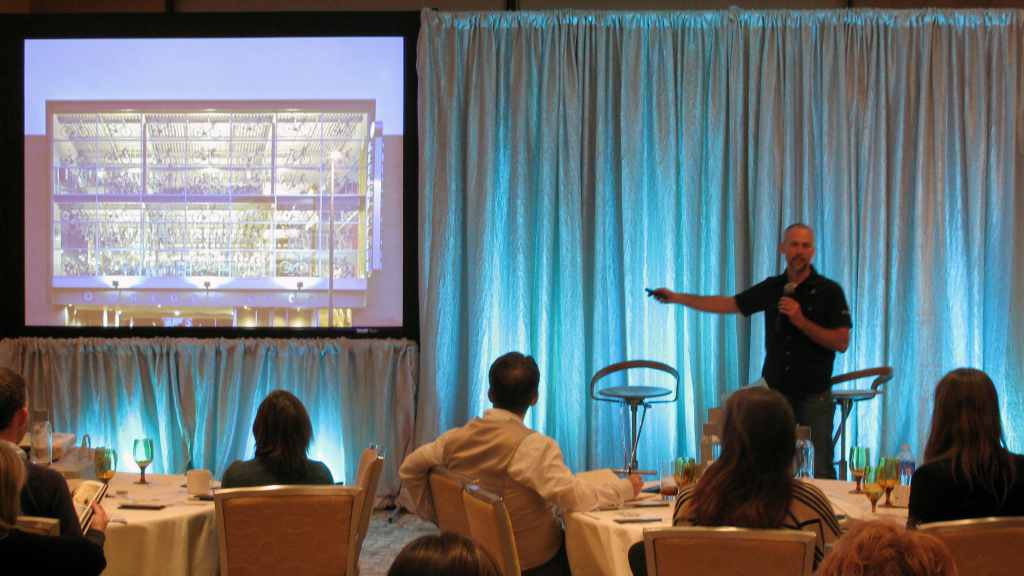



Jeremy started off by distributing the latest edition of the Trek catalog. To be truthful, the word “catalog” doesn’t come close to describing what a stunning book it is, packed with breathtaking photos of enthusiast riders using Trek bikes in some of the most beautiful settings you can imagine.
From the moment that his catalogs were in our hands, Jeremy was off and running. Here are some excerpts from what he had to say.
Jeremy first projected an image of a gorgeous, sleek bike onto the presentation screen.
“This is a $15,000 bike,” he said. “It weighs 10.25 pounds.”
Jeremy then showed us the image of another bike and said, “This is a $10,000 bike. It has brand-new Shimano stuff on it. There are only six bikes in the world that have this equipment on them, and we have them all.”
Next came an image of another Trek bike – a bike made for city streets that sells for $800. Then Jeremy showed us an image of the fastest bike in the world – a $10,000 experimental Trek bike that has gone faster than any bicycle ever created.
Then Jeremy surprised us by saying, “I can’t sell you any of these bikes. You can’t go to trekbikes.com and buy a bike. You can’t buy these bikes from me. Every bike we sell has to go through an independent retailer. And that’s really important. As somebody else said in an earlier talk, we are only successful if our shops are successful. We don’t have a multi-channel approach.”
Jeremy then showed an image of a very beautiful bicycle shop with state-of-the-art displays. Then he projected a picture of a run-down looking shop with crude signs. He also showed images of different bicycle retailers’ websites. Some of them were very beautiful and well done – others were downright awful.
“We have thousands of retailers and store owners North America alone,” Jeremy said, “Most of the store owners didn’t start out thinking about becoming a businessperson. Most of them started working in bike shops. They might have started out as mechanics, then they became salespeople. But they’re all passionate about bikes.”
“It took us a long time to figure out who we are as a brand,” Jeremy stated. “Now, at Trek, we do know. We have this beautiful brand. We believe that bikes are a big deal. We believe in bikes. We also know that we were born when two guys got together in a barn but that today, we have rocket scientists – we actually have rocket scientists working on our bikes. We also know that if you bought one of our bikes 20 years ago, you still have a warranty on that bike, and that is part of our story. We understand that the world needs heroes, and that cycling provides some of those heroes. We are now a global company, we’re all over the world.”
That is the Trek story, but “ultimately, our retailers are the ones who have to tell that message,” Jeremy said. “That is one reason why we came up with that beautiful catalog. Sometimes retailers look at it and say, ‘where is the list of products?’ and we put one in. But the purpose of the catalog is to help tell our retailers what our brand is all about, so they can convey that excitement to customers.
“At times, our retailers haven’t been doing a great job of telling those stories. That’s one reason we turned to Promoboxx, which is helping us to get our retailers to do that. We believe in bikes. Promoboxx believes in retailers. And we know that retailers are the only way that we can sell our bikes. It’s a really nice fit there.”
Jeremy didn’t mince words when describing the challenge of getting stores to convey his brand message. In the past, he has used seminars and webinars to speak to them. But ultimately, he explained, “The guy who is selling our bikes came from the background of being a mechanic. So how do we get that brand information to that salesperson and get him or her to use it?
“We used to go to a big show in Vegas, which was mostly about a bunch of dudes hanging out and showing off their bikes and saying, `Look at us, we are really cool!’ So we stopped going to that event, where we weren’t getting our retailers’ full attention. Now every summer, we get all of our best retailers together. We show them our bikes, just our bikes, on beautiful displays. But they also become a part of things. They go to seminars at that meeting, which are sort of like the one I am giving you now.”
Jeremy and his team have created what he calls “a huge toolbox of stuff” for dealers to use to promote the Trek brand and sell more units. He states that Promoboxx is one of those tools. He also mentioned Retail Cornerstones, which he describes as “a print-on-demand system” that delivers POP materials into stores.
But something of a paradigm shift happened when Trek launched Trek University, a unique entity that Jeremy and his team created to deliver literally tens of thousands of tutorial videos, quizzes, and podcasts directly to store owners and salespeople on the retail floor. The goal of TU has been to make dealers and their staffs “the most knowledgeable in the world.”
As salespeople and retailers acquire skills and knowledge at Trek University, they graduate to different learning levels. Trek distributes incentives like gloves and bike saddles to encourage retail personnel to reach the highest “Ninja” level of education that the University offers.
“When we get shops engaged in Trek University, who want to get 100% of their sales staff up to Ninja status,” Jeremy explained, “we find that those shops are 5% more profitable than our other stores.”
As Trek University was expanding its offerings, Jeremy and his team discovered that it offered them another opportunity – the opportunity to help retailers become better businesspeople.
“Some of our store owners never created marketing or business plans,” Jeremy stated. “So we began to show them how to do that. Then we became more involved in teaching business skills. We even started to offer instruction about HR functions. And you have to remember that HR plays a part in delivering our brand value too. We believe that when stores hire salespeople who can interview well when applying for a job, those salespeople will be likely to know how to sell better. Ultimately, it is a problem in which someone who is earning $10/hour is selling a product that could sell for $15,000. He or she has to have a concept of how to talk to that kind of customer. That is one reason Trek University became a way to not only talk about bicycles, but about business too.”
As Jeremy’s talk was winding down, he stated, “Another thing is that salespeople sell what they ride. In my early days when I was a salesperson, I sold people the same bike over and over – it was an awful bike – because it was the bike that I rode. So we realized that if we can get salespeople on our products, they are going to sell our products. Most of our retailers have all of our competitors’ products on their floors as well. We needed to introduce salespeople to our products, so they would start to sell them. That is one reason why we need direct communication with them, through Trek University.”
And here’s another valuable piece of practical advice from Jeremy.
“We send emails directly to salespeople and we have found that we have a 50% open rate on them. It’s huge. We talk to them in the way that they want to hear.”
We can’t thank Jeremy enough for sharing his insights with everyone who attended Aligned!
Jeremy has spent more than 15 years working in one of the largest cycling retailers in the US. Prior to Trek Bicycle, he worked for the GAP, in mental hospitals, and “emotional growth boarding schools.” This wide range of experiences informs Jeremy’s work with retailers. With thousands of independent retailers worldwide, he has his work cut out for him!

